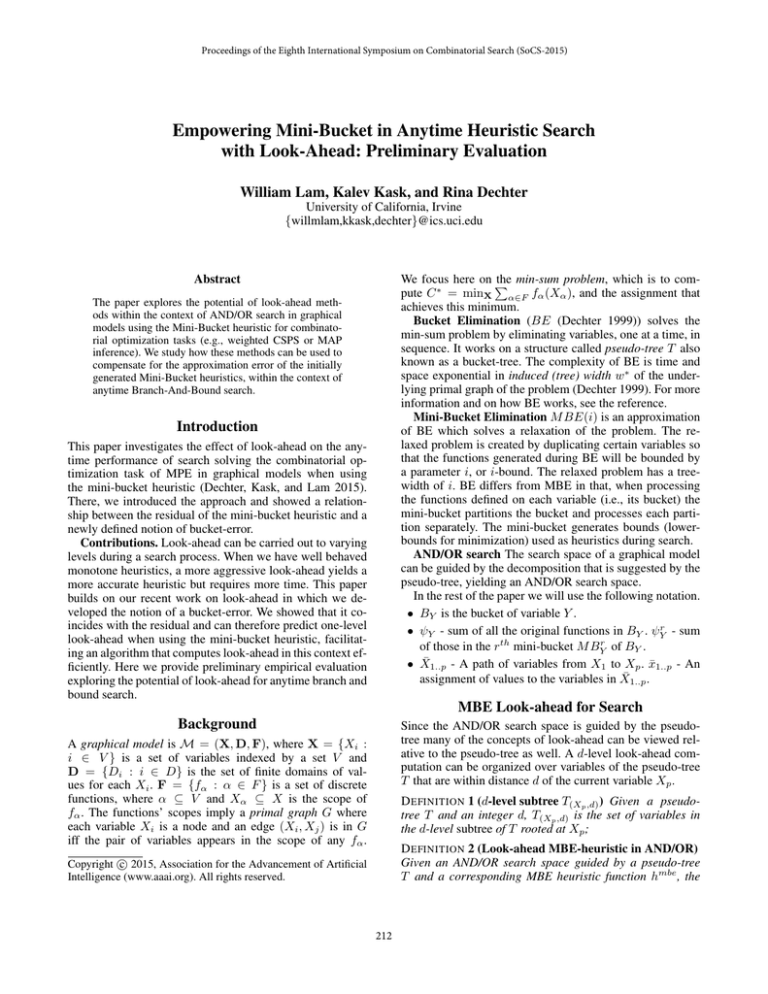
Proceedings of the Eighth International Symposium on Combinatorial Search (SoCS-2015)
Empowering Mini-Bucket in Anytime Heuristic Search
with Look-Ahead: Preliminary Evaluation
William Lam, Kalev Kask, and Rina Dechter
University of California, Irvine
{willmlam,kkask,dechter}@ics.uci.edu
Abstract
We focus here on P
the min-sum problem, which is to compute C ∗ = minX α∈F fα (Xα ), and the assignment that
achieves this minimum.
Bucket Elimination (BE (Dechter 1999)) solves the
min-sum problem by eliminating variables, one at a time, in
sequence. It works on a structure called pseudo-tree T also
known as a bucket-tree. The complexity of BE is time and
space exponential in induced (tree) width w∗ of the underlying primal graph of the problem (Dechter 1999). For more
information and on how BE works, see the reference.
Mini-Bucket Elimination M BE(i) is an approximation
of BE which solves a relaxation of the problem. The relaxed problem is created by duplicating certain variables so
that the functions generated during BE will be bounded by
a parameter i, or i-bound. The relaxed problem has a treewidth of i. BE differs from MBE in that, when processing
the functions defined on each variable (i.e., its bucket) the
mini-bucket partitions the bucket and processes each partition separately. The mini-bucket generates bounds (lowerbounds for minimization) used as heuristics during search.
AND/OR search The search space of a graphical model
can be guided by the decomposition that is suggested by the
pseudo-tree, yielding an AND/OR search space.
In the rest of the paper we will use the following notation.
• BY is the bucket of variable Y .
• ψY - sum of all the original functions in BY . ψYr - sum
of those in the rth mini-bucket M BYr of BY .
• X̄1..p - A path of variables from X1 to Xp . x̄1..p - An
assignment of values to the variables in X̄1..p .
The paper explores the potential of look-ahead methods within the context of AND/OR search in graphical
models using the Mini-Bucket heuristic for combinatorial optimization tasks (e.g., weighted CSPS or MAP
inference). We study how these methods can be used to
compensate for the approximation error of the initially
generated Mini-Bucket heuristics, within the context of
anytime Branch-And-Bound search.
Introduction
This paper investigates the effect of look-ahead on the anytime performance of search solving the combinatorial optimization task of MPE in graphical models when using
the mini-bucket heuristic (Dechter, Kask, and Lam 2015).
There, we introduced the approach and showed a relationship between the residual of the mini-bucket heuristic and a
newly defined notion of bucket-error.
Contributions. Look-ahead can be carried out to varying
levels during a search process. When we have well behaved
monotone heuristics, a more aggressive look-ahead yields a
more accurate heuristic but requires more time. This paper
builds on our recent work on look-ahead in which we developed the notion of a bucket-error. We showed that it coincides with the residual and can therefore predict one-level
look-ahead when using the mini-bucket heuristic, facilitating an algorithm that computes look-ahead in this context efficiently. Here we provide preliminary empirical evaluation
exploring the potential of look-ahead for anytime branch and
bound search.
MBE Look-ahead for Search
Background
Since the AND/OR search space is guided by the pseudotree many of the concepts of look-ahead can be viewed relative to the pseudo-tree as well. A d-level look-ahead computation can be organized over variables of the pseudo-tree
T that are within distance d of the current variable Xp .
A graphical model is M = (X, D, F), where X = {Xi :
i ∈ V } is a set of variables indexed by a set V and
D = {Di : i ∈ D} is the set of finite domains of values for each Xi . F = {fα : α ∈ F } is a set of discrete
functions, where α ⊆ V and Xα ⊆ X is the scope of
fα . The functions’ scopes imply a primal graph G where
each variable Xi is a node and an edge (Xi , Xj ) is in G
iff the pair of variables appears in the scope of any fα .
D EFINITION 1 (d-level subtree T(Xp ,d) ) Given a pseudotree T and an integer d, T(Xp ,d) is the set of variables in
the d-level subtree of T rooted at Xp ;
D EFINITION 2 (Look-ahead MBE-heuristic in AND/OR)
Given an AND/OR search space guided by a pseudo-tree
T and a corresponding MBE heuristic function hmbe , the
c 2015, Association for the Advancement of Artificial
Copyright Intelligence (www.aaai.org). All rights reserved.
212
Figure 1: Selected instances. The solution quality is plotted as a function of time per instance (in log scale).
d-level look-ahead heuristic of hmbe at Xp is a function,
lh(d)
whose scope is subsumed in X̄1..p , denoted hXp (sp ),
sp = x̄1..p
become more preferable. In results on exact search (Dechter,
Kask, and Lam 2015), a look-ahead depth of 2-3 often performed the best even for the same set of lower i-bounds,
with deeper look-ahead yielding decreased performance due
to time overhead. Here, we see that deeper look-ahead can
give superior early anytime performance.
lh(0)
• hXp (sp ) = hmbe
Xp (sp )
X
lh(d)
lh(d−1)
• hXp (sp ) =
min(ψY (sp , y) + hY
(sp , y))
Y
Y ∈child(Xp )
Conclusion
The d-level residual at Xp is
•
lh(d)
resXp (sp )
=
lh(d)
hXp (sp )
−
We performed a preliminary evaluation of the effect of lookahead on the anytime performance of solving MPE. Our results show that look-ahead can be a cost effective method of
achieving higher quality solutions sooner, especially when
the heuristic is weak. The search time is also a factor, suggesting that it may also be beneficial to dynamically change
the look-ahead depth over time. Future work in estimating
the residual and its relative effect during search can guide us
towards more flexible look-ahead subtrees for this purpose.
hmbe
Xp (sp )
Experiments
We ran AND/OR Branch and Bound (AOBB) (Marinescu
and Dechter 2009) using the state-of-the-art MBE-MM
heuristic (Ihler et al. 2012) on 3 different benchmarks with
a time bound of 6 hours for each instance. To evaluate the
general impact of look-ahead across a range of depths d, we
collected the solutions reported by our solver at various time
snapshots and reported those in instance by instance anytime
graphs.
Figure 1 plots the time vs. solution quality for an instance
from each benchmark. Points that are higher and to the left
indicate superior anytime performance. If a line runs off the
right end of the plot, it indicates that the problem was not
solved within the time bound. Each row of the figure corresponds to an particular problem instance and the columns
correspond to different i-bounds. In this small sample of our
results, we see indeed that the look-ahead scheme has a positive impact on anytime performance at earlier times, especially when the i-bound is lower. However, as the search time
and/or i-bound increase, shallower look-ahead depths can
References
Dechter, R.; Kask, K.; and Lam, W. 2015. Some properties
of look-ahead with mini-bucket heuristics. Technical report,
Unpublished, UC Irvine, ICS.
Dechter, R. 1999. Bucket elimination: A unifying framework
for reasoning. Artificial Intelligence 113:41–85.
Ihler, A.; Flerova, N.; Dechter, R.; and Otten, L. 2012. Joingraph based cost-shifting schemes. In Uncertainty in Artificial Intelligence (UAI). Corvallis, Oregon: AUAI Press. 397–
406.
Marinescu, R., and Dechter, R. 2009. And/or branch-andbound search for combinatorial optimization in graphical
models. Artif. Intell. 173(16-17):1457–1491.
213







